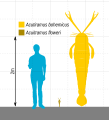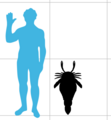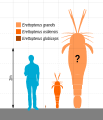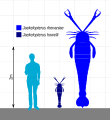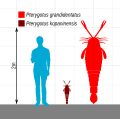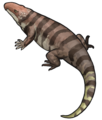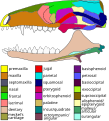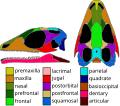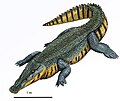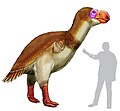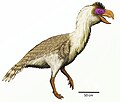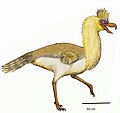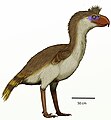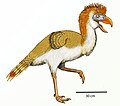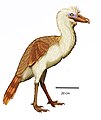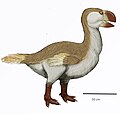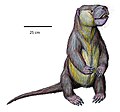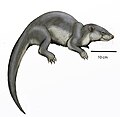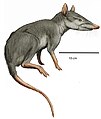Wikipedia:WikiProject Palaeontology/Paleoart review/Archive 29
| This is an archive of past discussions on Wikipedia:WikiProject Palaeontology/Paleoart review. Do not edit the contents of this page. If you wish to start a new discussion or revive an old one, please do so on the current main page. |
| Archive 25 | ← | Archive 27 | Archive 28 | Archive 29 | Archive 30 | Archive 31 |
Lanthanosuchoidea
Hello everyone. Can I get some review for another of my reconstruction. This time I tried to restore some of Lanthanosuchoidea species especially the acleistorhinids. The species are (top left to bottom clockwise): Delorhynchus, Colobomycter, Carbonodraco, Feeserpeton, Lanthanosuchus, and Acleistorhinus. Most of the reference are available on their respective page. But some of them are on paper that I will mention if some of you want to see the reference.
For the Lanthanosuchus, at first I feel it kinda strange and wonder why it looks like some crocodile or temnospondyls. But from the lateral view of several image (like this one although it is not from paper [1]) and after keep measuring the length from the tip of the snout to the eyes of several reconstructions like those of Dmitry Bogdanov, I reached this reconstruction.. But as always, I will gladly welcome any correction.. I want to upload this image to Lanthanosuchoidea page. And if not all of them are acceptable, I can just upload some of them.. Thank you in advance as always..

DD (talk) 14:59, 15 February 2024 (UTC)
- I am sorry to say, but I presumed that there are no major error for the reconstruction? I am going to upload it to the Lanthanosuchoidea page. But as always, just take it down if there are glaring inaccuracies that I am not aware to. Thank you.. DD (talk) 11:38, 22 February 2024 (UTC)
- They look good from a quick glance, though I do have a few minor questions or concerns:
- I would double-check Feeserpeton to make sure that breakage or other taphonomic factors are not giving undue influence to the shape of the snout.
- This is a very minor concern, but I'm not sure if it's ideal to figure Lanthanosuchus in lateral view, simply because the skull is so distinctly flattened. Lateral view is more conjectural and less anatomically useful than something like dorsal view for that genus. We don't know exactly how much compression occurred during fossilization, while most of the others have great 3D preservation thanks to the conditions of Richards Spur.
- If Colobomycter has exposed fangs (and I don't disagree with that choice), then Carbonodraco should as well. You should also clarify in the description which species of Colobomycter you're illustrating.
- A lot of acleistorhinids (especially Lanthanosuchus) have distinctly pitted skull bones, which may imply a very thin skin texture more akin to temnospondyls or gars than to lizards. But that's just something to keep in mind, there isn't a pressing need to alter the art accordingly.
- I would recommend covering up the external ear holes with skin. Unlike neodiapsids, most parareptiles had thick squamosal and quadratojugal bones which covered up the quadrate, the bone which supports the eardrum in most modern reptiles. There were some parareptiles with embayed skulls which may have had ear structures on par with modern reptiles (nycteroleterids as the biggest example), but for most I would doubt that they had exposed ears. NGPezz (talk) 03:20, 23 February 2024 (UTC)
- Thank you very much for the response and input. Regarding thoses:
- - Ah I see. To be frank, I am also kind of uncertain whether the conture of the skull upper part is like that or it is taphonomical. But since I can't find reconstruction beside the CT scan of the skull and the image from the Wiki, I am sorry that I made it that way
- - Ah I see. I thought that I want to show the side view of the animal since most of reconstructions show them from their dorsal side..
- - For the Carbonodraco, I think that its fang are not as elongated as Colobomycter and want to give a variation like in the case of Tasmanian devil and quoll. Although their skull and canine length are quite similar, only the tasmanian devil that have canines that are visible from the outside (as far as I know)... Oh and I am sorry. The species is C. pholeter. I will add it to the description..
- - Ah I see. I will keep in that in mind
- - Wow, I am not aware of that! Thank you very much for the new and interesting information...
- I will try to fix the things I can like erasing the ear holes and think again about the exposed fang.. DD (talk) 04:31, 23 February 2024 (UTC)
- No worries about Feeserpeton, taphonomy is just something to always be aware of. In the original 2012 description,[2] I can see that the little droop at the tip of the snout is mostly limestone with only a few "uninformative fragments" of the premaxilla. So it does seem to be taphonomic rather than anatomical. Are you able to access the description? If not, check around to see if you have access through wikipedia library or your university system, or if all else fails pursue other means.
- I don't have too much of a problem with illustrating Lanthanosuchus in side view, I just wanted to bring up how dorsal view is typically the most rigorous and informative perspective you can take for animals with flattened skulls. If you're intentionally trying to avoid that cliche, I fully respect that choice.
- Proportionally, Carbonodraco and Colobomycter look about the same in terms of fang length, at least to me. Their fangs also seem to poke down beyond the edge of the lower jaw, which to me seems to be a classic case of the fangs not being covered. The skull texture (thin skin?) I mentioned earlier is another contributor to my perspective, mammals and lizards and other tetrapods with thick-skinned or muscular skulls are not the most ideal model.
- The tasmanian devil/quoll analogy is an artistic choice which is perfectly acceptable by itself, but it's not fully compatible with Wikipedia's mission and role in science education. A very important thing to consider for Wikipedia paleoart is that it is often the most visible and most accessibly licensed art for obscure species, and much of the populace cannot easily distinguish artistic license from scientific interpretation even if context is provided. Introducing speculative flourishes inspired by the eccentricities of specific modern species (like strong variation in lip depth among close relatives) is far from a bad thing in the wider sphere of paleoart, I'm fully supportive of the All Yesterdays approach. However, in an encyclopedic resource like Wikipedia, this high degree of specificity may give people the wrong impression that your artistic choices are informed by definitive evidence. It's the same reason why we had to reject visually appealing art pieces like this one:[3]. The composition could not function without bioluminescent Amiskwia, an artistic choice which was partially inspired by the fact that a few modern arrow worm species have bioluminescent organs. The problem is that the lines of inference were stretched extremely thin: Amiskwia was not necessarily close to arrow worms, most arrow worms are not bioluminescent, and those that do use bioluminescence have it concentrated into only a few tiny spots rather than the whole body glowing green. In any other context, this is fine, since it's not demonstrably "inaccurate" and it makes for a nice piece of art. But in Wikipedia it strayed way too close to WP:Original Research; we don't want people to assume that Amiskwia was bioluminescent because of one artist's idea for a fun composition. NGPezz (talk) 17:26, 23 February 2024 (UTC)
- I am really sorry for my late reply
- - Ah I see. I will try to take a closer look at the original description from that link..
- - Thank you very much for your understanding of avoiding the cliche.. But yes I guess you are right. I am not taking account of the fact that the skull could he flattened becauae of geological process..
- - On closer look, I have to admit that yes their fang proportion is kinda similar.. I guess the next time I redraw them, I have to stick to either lipless or lipped look for the consitency
- - Ah I see. I guess you are right about not taking all yesterday approach to heavily when it comes to wikipedia reconstruction eventhough it is still plausible..
- Well, I guess my reconstruction of them need to be fixed then in many aspects.. Please put the inaccurate label in my image so it can be taken down. I am okay with that since it got many major issues.. Once again, thank you very much for the input and a lot of new information about them! DD (talk) 23:27, 25 February 2024 (UTC)
- They look good from a quick glance, though I do have a few minor questions or concerns:
Acanthostega Restoration

Wanted to do an updated restoration of Acanthostega, the cranial reconstruction is based on "Descriptive Anatomy and Three-Dimensional Reconstruction of the Skull of the Early Tetrapod Acanthostega gunnari Jarvik, 1952" and the postcrania is based on "The Devonian tetrapod Acanthostega gunnari Jarvik: postcranial anatomy, basal tetrapod interrelationships and patterns of skeletal evolution", was wondering if i needed to fix anything before uploading SeismicShrimp (talk) 00:04, 1 March 2024 (UTC)
Older restorations of Ekaltadeta by Nobu Tamura
-
Ekaltadeta ima (older version)
-
Ekaltadeta ima (new version)
Now that a new illustration has passed, maybe it is time to consider reviewing the two previous illustrations. If the shape of the skull seems on par with our modern understanding of their anatomy, the body shape seems extremely speculative, more evocative of modern macropods than to its direct modern relative, the musky rat-kangaroo. The forelimbs in particular are remarkably long, something that does not seem to be substantiated in the litterature. Larrayal (talk) 02:14, 25 February 2024 (UTC)
- Probably not worth editing them now we have a better one, so could just be tagged. FunkMonk (talk) 00:26, 1 March 2024 (UTC)
Toxoprion restoration
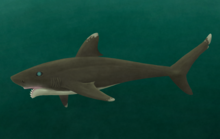
So I noticed that this restoration of the eugeneodont Toxoprion by Gasmasque was never formally reviewed. Are there any issues with it?. Fossiladder13 (talk) 05:31, 2 March 2024 (UTC)
- I think tail fin of Eugeneodonts are mostly symmetrical, so not sure that shape like modern shark would be possible. Ta-tea-two-te-to (talk) 10:02, 2 March 2024 (UTC)
- @Ta-tea-two-te-to that is true, but aside from that, I don't really see that many issues with it. It correctly lacks anal and secondary dorsal fins, it has a caudal keel, and I believe the number of gills is correct. I'll ping @Gasmasque about it. Fossiladder13 (talk) 21:10, 6 March 2024 (UTC)
- Apologies for the late reply, I've not been as active on the site as of recent. The chimaera-like eye on this reconstruction is not plausible for what would most likely be a shallow water fish, the whorl anatomy is not consistent with that of an adult of this species, with a small number of comparatively very large teeth, and the aforementioned caudal fin anatomy is not consistent with Caseodonts (although given the caudal anatomy of Helicoprionids is entirely unknown I think this is actually the least pressing issue here). This was among my first contributions to the site, and in retrospect I don't think it is appropriate to use a life restoration at all for a taxon known only from whorls.
- Also, regarding all future reviews of Eugeneodonts, it is entirely plausible they did retain pelvic fins, especially Edestids and Helicoprionids, and that those of Caseodonts were simply reduced and quick to decay or become damaged, and I don't think reconstructions of them should be struck as inaccurate because of including those. It is also totally plausible, given the recent description of Cosmoselache, that extinct Holocephs (or stem-chondrichthyans that were originally considered Holocephs, I should say) potentially including Eugeneodonts really did have a chimaera-like operculum after all, considering Symmoriiformes appear to have had one. It may be too early to say for sure, but it is entirely likely this reconstruction has incorrect gill and pelvic anatomy as well as the problems more definitively addressed. Gasmasque (talk) 08:10, 9 March 2024 (UTC)
- Very interesting, thank you for replying 👍 Fossiladder13 (talk) 16:30, 9 March 2024 (UTC)
- @Ta-tea-two-te-to that is true, but aside from that, I don't really see that many issues with it. It correctly lacks anal and secondary dorsal fins, it has a caudal keel, and I believe the number of gills is correct. I'll ping @Gasmasque about it. Fossiladder13 (talk) 21:10, 6 March 2024 (UTC)

Noticed this image by @Cambrian dude52: was added without review. I think it looks fine, maybe image is bit too dark to see, what do you think @Junnn11: since you have worked on Japanese article of this taxon? Ta-tea-two-te-to (talk) 14:46, 12 March 2024 (UTC)
- I agree that the image is a little dark, but to be fair, that is how deep the Sirius Passet site is. Although one thing to note is that the restoration in the paper shows the animal with "eyes" (though that may be artistic license). Also love the red coloration of the creature. Fossiladder13 (talk) 15:04, 12 March 2024 (UTC)
- Yes, the image is too dark. Regardless of the realism of such an environment, it is almost useless on the page if you can hardly make out the animals' forms in a small thumbnail. -SlvrHwk (talk) 15:50, 12 March 2024 (UTC)
- Considering the image is a 3D reconstruction, perhaps we can just use the model for Timorebestia. Fossiladder13 (talk) 16:04, 12 March 2024 (UTC)
- Yes, the image is too dark. Regardless of the realism of such an environment, it is almost useless on the page if you can hardly make out the animals' forms in a small thumbnail. -SlvrHwk (talk) 15:50, 12 March 2024 (UTC)
- The morphology looks good, but as noted, the darkness is a major issue to make it useful.
- So far there's no evidence of eyes in Timorebestia (stated as unknown in the character coding of the original description), so perhaps its still ok to make it blind, but I think it's also worth to note that modern chaetognath have a pair of simple eyes. Junnn11 (talk) 09:52, 13 March 2024 (UTC)
- Thanks for the feedback and sorry about adding the image without review, I didn't know about this page until now. I will be remaking this without an environmental reconstruction for better clarity. Cambrian dude52 (talk) 03:37, 14 March 2024 (UTC)
- How does this render for Timorebestia look? I'm still uncertain about it having eyes and I don't recall the paper mentioning anything about it's eyes. So I am deciding to leave them absent until further notice.

- Cambrian dude52 (talk) 04:34, 14 March 2024 (UTC)
- It looks good now! Thank you for the update! The eye was stated uncertain in the supplementary materials, as well as other fossil chaetognaths ("character 51. Head with cerebral eyes" from page 7 of the pdf file). Junnn11 (talk) 14:18, 15 March 2024 (UTC)
- Thanks for the feedback and sorry about adding the image without review, I didn't know about this page until now. I will be remaking this without an environmental reconstruction for better clarity. Cambrian dude52 (talk) 03:37, 14 March 2024 (UTC)
Pterygotidae members
-
Pterygotus
-
Erettopterus (with inaccurately segmented chelicerae)
-
Ciurcopterus (with inaccurately segmented chelicerae)
-
Ciurcopterus (with inaccurately segmented chelicerae)
-
Jun's pterygotids
-
Acutiramus cummingsi, I think this still works as historical art
-
Bonus: Eurypterid diversity image by Qohelet12, it descript shorter pedipalp of Acutiramus
Recent study about pterygotidae Acutiramus shows new 3D reconstruction,[4] more anterior insertion of appendages II–V, a near-horizontal orientation of appendages II–VI coxae, the presence of reduced appendage II (which was evident for Erettopterus and Ciurcopterus), and a labrum and epistomel region. For chelicerae, length of stem and placement got revision, it looks like became longer. Jun will update their reconstructions later, but what about other reconstructions? If it is hard to edit maybe just tag outdated and replace it into Jun's one would be fine? Ta-tea-two-te-to (talk) 14:17, 27 November 2023 (UTC)
- Yeah, replacing them with Jun's restorations if they are hard to edit would work, but as you mentioned that Acutiramus diagram could work as historical art. Fossiladder13 (talk) 15:24, 27 November 2023 (UTC)
- Qohelet12 did some very good edits before, maybe they can rescue some? FunkMonk (talk) 15:57, 27 November 2023 (UTC)
- That is also a possibility, however I have not heard from them for a while, so it seems that they may be busy at the moment. Fossiladder13 (talk) 16:12, 27 November 2023 (UTC)
- Now Qohelet sent me fixes of these images, I will try to upload them. Ta-tea-two-te-to (talk) 01:54, 25 December 2023 (UTC)
- I've updated the DB and Abelov images with Qohelet12's versions. FunkMonk (talk) 02:34, 25 December 2023 (UTC)
- Qohelet12 did some very good edits before, maybe they can rescue some? FunkMonk (talk) 15:57, 27 November 2023 (UTC)
Size charts
-
Acutiramus
-
Ciurcopterus
-
Erettopterus
-
Jaekelopterus
-
Pterygotus
Works by @Slate Weasel: and @Ichthyovenator:. These works probably needs update as well, putting legs other than paddle more forward and make pedipalp much shorter, and possibly longer stalk of chelicerae. Especially Acutiramus, Erettopterus and Cirucopterus are ones with known all legs so would be helpful.
- Acutiramus shape can be updated to shape based on 2023 study. Since A. cummingsi (species used in original shape) is small species, I think A. macrophthalmus is more reasonable for shape of A. bohemicus.
- Ciurcopterus shouldn't have segmentation on stalk of chelicerae. There is fossil preserved anterior body,[5] which show anterior placement of legs.
- Erettopterus have same issue on chelicerae stalk. In addition this genus is one with known shorter pedipalps, probably good to see reference used in this reconstruction.[6]
- Body shape of Jaekelopterus chart here is just based on art by Dmitry Bogdanov, but for body shape reconstruction in 2007 paper is more reasonable.[7] I think I have seen screenshot of reconstruction of Jaekelopterus in older paper (on tweet of @Junnn11:) and it was similar to reconstruction in 2007 paper.
- Pterygotus which got update recently is fine for body shape, just legs need update probably.
It will be so hard to fix all of them, but I hope this will help. Ta-tea-two-te-to (talk) 03:33, 30 November 2023 (UTC)
- Thanks for the mentions @Ta-tea-two-te-to! Recently I've updated all of my pterygotid works based on Bicknell et al. 2023. Hope it helps.
- Another notable issue is the proportion of chelicerae (which was fixed in the new study as well):
- The bases should be concentrated anteromedially instead of seperated laterally like decapod chelipeds, since the attachment points (sides of epistome-labrum) are very close to each other and located just immediately behind the anterior margin of prosoma.
- Some of them seemly have a mesially-located movable fingers (again, like many decapod chelipeds). However as a chelicera's chelate in general, the movable fingers are more likely have a lateral position instead.
- Junnn11 (talk) 07:00, 30 November 2023 (UTC)
- Yeah, a lot of these size charts are pretty old, and, to be blunt, pretty bad (the Jaekelopterus stands out as particularly egregious, made before I had any understanding of arthropod anatomy). My current project is to update my ceratopsids, but I'll try to get around to these guys this December too (I already had plans to update Erettopterus soon anyways). I see that the Jaekelopterus article shows various nearly complete specimens; have any of those been described in the literature? --Slate Weasel [Talk - Contribs] 00:37, 1 December 2023 (UTC)
- I'm not sure if the specimens had been formally described since I don't have access to most of Størmer's papers, which have detailed descriptions on Jaekelopterus rhenaniae (Pterygotus rhenaniae at that time) according to some recent literatures.
- The famous full-body reconstruction by Braddy et al. 2008 seems to be largely based on a traditional drawing (Størmer 1944 Fig. 10. 1 as far as I know). Carapace and partial opisthosoma was described by Poschmann & Tetlie 2006, but these are juveniles and some features (especially the eyes and telson) are considered quite different from the adult, thus I think it's not a good reference for maximun size diagram. Recently, some large fragments of J. howelli was described by Lamsdell & Selden 2013. Junnn11 (talk) 07:21, 1 December 2023 (UTC)
- Yeah, a lot of these size charts are pretty old, and, to be blunt, pretty bad (the Jaekelopterus stands out as particularly egregious, made before I had any understanding of arthropod anatomy). My current project is to update my ceratopsids, but I'll try to get around to these guys this December too (I already had plans to update Erettopterus soon anyways). I see that the Jaekelopterus article shows various nearly complete specimens; have any of those been described in the literature? --Slate Weasel [Talk - Contribs] 00:37, 1 December 2023 (UTC)
- Ta-tea-two-te-to & Junnn11: I've updated the Acutiramus chart with new silhouettes; how does this look? --Slate Weasel [Talk - Contribs] 13:27, 3 January 2024 (UTC)
- Nice! As a minor detail, I think the pretelson can be widen a bit (just like the previous reconstruction). Junnn11 (talk) 13:40, 3 January 2024 (UTC)
- Thanks, I've broadened the pretelson, does this look better? I've also made corrections to the limbs of the Pterygotus, do those look okay? --Slate Weasel [Talk - Contribs] 14:03, 3 January 2024 (UTC)
- Thanks for the updates! Another details, I think the proportion of Pterygotus appendage II-V can be reconstructed like those of Acutiramus (II very short; III~V subequally long), although appendage II are still unknown in Pterygotus & Jaekelopterus, these 4 pairs of appendages seems to have no significant differences across pterygotids (except Ciurcopterus, which were a bit more robust). Junnn11 (talk) 14:22, 3 January 2024 (UTC)
- Is appendage II actually unknown in Pterygotus? This specimen: [8] seems to preserve all four walking legs on one side, and is what I used as reference for limb proportions, though as I'm not very familiar with arthropods I may just be misinterpreting how it's preserved. --Slate Weasel [Talk - Contribs] 14:37, 3 January 2024 (UTC)
- That's interesting... I'm not sure if any subsequent studies had take notes on this conflict, or perhaps just taphonomic effect of disarticulated appendages? Interestingly, the reconstruction from the same publication considered only 3 pairs of long legs, precede future research. Also be aware the purported "short appendage II of Pterygotus" illustrated by Huxley & Salter 1859 is those of Slimonia, which were classified under Pterygotus at that time.
- The idea of all pterygotids have reduce appendage II was started from Selden 1986. this was further supported by the discovery of unambiguous appendage II in Ciurcopterus and Acutiramus. The reconstruction of Pterygotus in King et al. 2017 also follow this idea and propose a sensory function. It seems unlikely that Pterygotus could be an exception, based on its overall resemblance to other pterygotids and relatively derived phylogenetic position. Junnn11 (talk) 15:57, 3 January 2024 (UTC)
- Yeah I agree that II of Pterygotus should be safer to make short like Acutiramus. By the way you mentioned that some length estimations of pterygotids (e.g. Braddy et al. 2008) are excluding telsons on Twitter. I also found that mainly because estimated length difference of A. bohemicus between Chlupac (1994)[9] and Braddy et al. (2008)[10] even through used same reconstruction from Ruedemann, 1912 (A. cummingsi recon above). I am not sure how to treat that because I can't find paper clarified to exclude telson from length, probably just treat it as total length including telson is safer here? Ta-tea-two-te-to (talk) 16:24, 3 January 2024 (UTC)
- Yeah...a modification of all diagram is required if that's true. As for Pterygotus, the ratio (free ramus:body length=1:9) was based on Woodward's description according to the same paper. When measuring the specimen mentioned above (minus the disarticulating gaps between some tergites), It's certainly that the ratio could only reach until pretelson, a 1:>10 ratio is required to include the whole telson. I still haven't check either the same goes for other eurypterids (i.e. the inclusive size estimation of Lamsdell & Braddy 2009) so recently I can't say for sure. Junnn11 (talk) 02:39, 4 January 2024 (UTC)
- I've shrunk appendage II in Pterygotus; I can also rescale the silhouettes if need be. I'm currently working on Erettopterus, hopefully I'll have that done before the end of Sunday. --Slate Weasel [Talk - Contribs] 17:09, 4 January 2024 (UTC)
- Thanks for the edits! About the body length issue, one of the author clarified that telson was included (via twitter). But under this measurement, the opisthosoma (except pretelson and telson) of Pterygotus, Acutiramus and Jaekelopterus would need to shrunk a bit relative to other body parts (which have approximately consistent ratios across the whole family). Opisthosoma of Erettopterus might not need to change if the ratio follow the reconstruction by Ciurca & Tetlie 2007. If the 4 genera scale down to identical size of free rami, the proportion difference might roughly look like this. Junnn11 (talk) 17:24, 6 January 2024 (UTC)
- I've shrunk appendage II in Pterygotus; I can also rescale the silhouettes if need be. I'm currently working on Erettopterus, hopefully I'll have that done before the end of Sunday. --Slate Weasel [Talk - Contribs] 17:09, 4 January 2024 (UTC)
- Yeah...a modification of all diagram is required if that's true. As for Pterygotus, the ratio (free ramus:body length=1:9) was based on Woodward's description according to the same paper. When measuring the specimen mentioned above (minus the disarticulating gaps between some tergites), It's certainly that the ratio could only reach until pretelson, a 1:>10 ratio is required to include the whole telson. I still haven't check either the same goes for other eurypterids (i.e. the inclusive size estimation of Lamsdell & Braddy 2009) so recently I can't say for sure. Junnn11 (talk) 02:39, 4 January 2024 (UTC)
- Yeah I agree that II of Pterygotus should be safer to make short like Acutiramus. By the way you mentioned that some length estimations of pterygotids (e.g. Braddy et al. 2008) are excluding telsons on Twitter. I also found that mainly because estimated length difference of A. bohemicus between Chlupac (1994)[9] and Braddy et al. (2008)[10] even through used same reconstruction from Ruedemann, 1912 (A. cummingsi recon above). I am not sure how to treat that because I can't find paper clarified to exclude telson from length, probably just treat it as total length including telson is safer here? Ta-tea-two-te-to (talk) 16:24, 3 January 2024 (UTC)
- Is appendage II actually unknown in Pterygotus? This specimen: [8] seems to preserve all four walking legs on one side, and is what I used as reference for limb proportions, though as I'm not very familiar with arthropods I may just be misinterpreting how it's preserved. --Slate Weasel [Talk - Contribs] 14:37, 3 January 2024 (UTC)
- Thanks for the updates! Another details, I think the proportion of Pterygotus appendage II-V can be reconstructed like those of Acutiramus (II very short; III~V subequally long), although appendage II are still unknown in Pterygotus & Jaekelopterus, these 4 pairs of appendages seems to have no significant differences across pterygotids (except Ciurcopterus, which were a bit more robust). Junnn11 (talk) 14:22, 3 January 2024 (UTC)
- Thanks, I've broadened the pretelson, does this look better? I've also made corrections to the limbs of the Pterygotus, do those look okay? --Slate Weasel [Talk - Contribs] 14:03, 3 January 2024 (UTC)
- Junnn11, Ta-tea-two-te-to, & Super Dromaeosaurus: I have updated the Erettopterus; how does it look? --Slate Weasel [Talk - Contribs] 16:38, 14 January 2024 (UTC)
- Looks good! Thank you! Super Dromaeosaurus (talk) 18:55, 14 January 2024 (UTC)
- Excellent! Thanks again! Junnn11 (talk) 06:36, 15 January 2024 (UTC)
- Junnn11, Ta-tea-two-te-to: I have updated Jaekelopterus, my apologies for the delay. I do not know when I will be able to fix the other images (I'd also like to update my Ciurcopterus, Pentecopterus, and Slimonia before doing so), but I'm hoping I will at least be able to do these over the summer, if not earlier. --Slate Weasel [Talk - Contribs] 11:38, 15 March 2024 (UTC)
- Thank you for the update! Glad to see the differences of chelicerae between the two species.
- Additionally, according to Braddy 2023, J. rhenaniae might had been more likely up to 2.6m (this time strictly based on the ratio of Pterygotus, which was purported to be closer relative of Jaekelopteus in that paper). But I think the 2.5m estimation is still more reliable (an average number of Acutiramus and Pterygotus-based estimation), since the alternated basis is yet to be confirm by any phylogenetic analysis.
- It's ok to delay, just take your time and no pressure. Junnn11 (talk) 14:04, 15 March 2024 (UTC)
- It looks nice indeed! Ta-tea-two-te-to (talk) 15:04, 15 March 2024 (UTC)
Colossosuchus
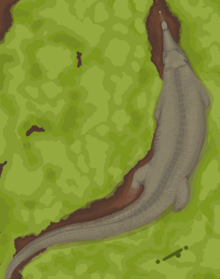
DNB XD (talk) 15:22, 9 February 2024 (UTC)
- It's a good base, though some corrections are needed. Try to get your hands on a copy of the original description by Datta & Ray (2023), it has a lot of great figures for reference. If you can access Wikipedia library, here[11] is a link. As for the room for improvement:
- The nostrils need to be visible in the rear part of the snout like other phytosaurs (fig. 5A and 23 A).
- It's not entirely clear whether the tip of the snout is fully visible or submerged in the mud. If it's not submerged, then the tip should be visibly expanded into a terminal rosette, once again like other phytosaurs (fig. 5A and 23A).
- I'm also not sure what the bulbous growth on the snout is meant to be. Colossosuchus does have a little bump in front of the nostrils (most easily visible at fig. 23C), but it's much more subtle and is shifted much further back than what is depicted here.
- The eyes are probably a bit too widely spaced, the space between the eye sockets is narrower in the fossil (fig. 5A and 23A, again).
- The paramedian osteoderms (i.e. the two rows above the backbone) are too small and narrow, available osteoderm fossils are broader and lumpier, with some overlap from front-to-back (fig. 22A, also note the skeletal at fig. 27).
- Colossosuchus apparently had some lateral osteoderms forming a row (one per side) next to the paramedians. The lateral osteoderms would have been smaller and more elliptical (fig. 22D), and were very sharply angled (fig. 22G).
- Finally, and this is just my opinion on the aesthetics rather than a scientific issue, but the art would benefit from some more color contrast between the phytosaur and the surrounding mud and pond scum. Clarifying the visual impact would help the average reader understand its anatomy at a quick glance. NGPezz (talk) 03:04, 12 February 2024 (UTC)
- Hey @DNB XD:, I just wanted to notify you to ask whether you wanted to make the edits I recommended for this art piece. NGPezz (talk) 03:14, 13 March 2024 (UTC)
- Ah! I didn't see it! I will! DNB XD (talk) 04:04, 14 March 2024 (UTC)
- I noticed that you've created a new version here:[12] It's greatly improved, though the bump on the snout is still too prominent in my opinion. Also, to upload revised versions of a file, use "Upload a new version of this file" in the file history on its wikimedia commons page. That will overwrite the old version of the file and prevent the clutter created by having two separate file pages for basically the same piece of art. NGPezz (talk) 23:14, 19 March 2024 (UTC)
- Ah! I didn't see it! I will! DNB XD (talk) 04:04, 14 March 2024 (UTC)
- Hey @DNB XD:, I just wanted to notify you to ask whether you wanted to make the edits I recommended for this art piece. NGPezz (talk) 03:14, 13 March 2024 (UTC)
Jormungandr
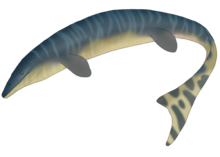
Made this reconstruction of Jormungandr walhallaensis a while back, now adding it to wiki for review. Based mostly on the material figured in its description paper, with missing elements filled in primarily by Clidastes (believed to be its closest relative). Olmagon (talk) 20:11, 20 March 2024 (UTC)
- Looks fine to me, but I don't know much about mosasaur reconstructions. I'm gonna reach out to some people and get back to you. --A Cynical Idealist (talk) 21:44, 20 March 2024 (UTC)
- Okay I spoke to one of the authors who described Jormungandr and they said it looks great, no notes. --A Cynical Idealist (talk) 06:09, 21 March 2024 (UTC)
- If it was Zietlow, I did communicate with her and ask for her advice on it as I drew it. Olmagon (talk) 09:22, 21 March 2024 (UTC)
- lmao it was, that's funny, small world. --A Cynical Idealist (talk) 19:21, 22 March 2024 (UTC)
- If it was Zietlow, I did communicate with her and ask for her advice on it as I drew it. Olmagon (talk) 09:22, 21 March 2024 (UTC)
Peltocephalus maturin
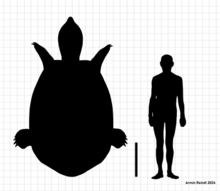
Nothing too fancy, just a quick size comparisson based on the paper measurements (1.7 meters SCL) and the size of the type mandible. Scalebar 50 cm. Armin Reindl (talk) 20:05, 22 March 2024 (UTC)
- Looks fine to me, it's only known from a jaw but the silhouette looks about right for a modern Peltocephalus scaled up. Olmagon (talk) 00:20, 23 March 2024 (UTC)
More ABelov2014 images
So I and others have uploaded a few more ABelov2014 images that could need review. FunkMonk (talk) 20:25, 23 February 2024 (UTC)
-
Illustration that seems to depict Adrienne Mayor's ideas of fossils inspiring legendary creatures
- Shouldn't Cymbospondylus have a dorsal fin? Lythronaxargestes (talk | contribs) 21:46, 23 February 2024 (UTC)
- That's probably the safer option, though I'm not sure if it would be visible from this angle. --Slate Weasel [Talk - Contribs] 13:42, 24 March 2024 (UTC)
In addition, here are some images that could be of use but that I haven't uploaded yet because I need some confirmation of accuracy or lack thereof:
https://www.deviantart.com/abelov2014/art/Synthetoceras-Platybelodon-660159972 Synthetoceras, Platybelodon - but were they contemporaries? ABelov2014 has a tendency to mix faunas
- According to this paper Synthetoceras is a little too old. Lythronaxargestes (talk | contribs) 22:31, 24 February 2024 (UTC)
- Alright, not really usable either, then. Unless the proboscidean can be identified as some other genus, maybe. FunkMonk (talk) 06:01, 25 February 2024 (UTC)
- I suppose they could be photoshopped into Blancotherium if one really wished. Lythronaxargestes (talk | contribs) 06:18, 25 February 2024 (UTC)
https://www.deviantart.com/abelov2014/art/Uintatherium-Hyracotherium-748511482 Uintatherium, Coryphodon, Eohippus - likewise, contemporaries?
- According to this paper you can get away with Coryphodon and relabelling Eohippus as Protorohippus venticolum, but Uintatherium is a little too young. Lythronaxargestes (talk | contribs) 21:59, 23 February 2024 (UTC)
- Alright, since Uintatherium is the focal point, probably no use in the image. FunkMonk (talk) 17:33, 24 February 2024 (UTC)
https://www.deviantart.com/abelov2014/art/Australia-hunting-stories-1021740361 Australovenator, Fulgurotherium, Diamantinasaurus - horns could be removed from the Australovenator
https://www.deviantart.com/abelov2014/art/orienburg-Uralosaurus-magnus-var-2-1021274370 - seems to be Donguz Formation fauna, older version with genera identified here:[13] FunkMonk (talk) 20:25, 23 February 2024 (UTC)
https://www.deviantart.com/abelov2014/art/Necks-long-1031928738 - How are these tanystropheids? FunkMonk (talk) 04:34, 17 March 2024 (UTC)
- I'm unaware of any preserved tanysaur soft tissue that supports the existence of a tail "paddle" as depicted here. Dinocephalosaurus definitely had paddle-esque limbs (they might be too smooth and plesiosaur-like here), but these are almost certainly too long (compare here). -SlvrHwk (talk) 09:28, 17 March 2024 (UTC)
- Oh, doesn't that make the Dinocephalosaurus restorations and size diagram we use in the article inaccurate, then? Also pinging Lythronaxargestes, who wrote the article. FunkMonk (talk) 14:22, 17 March 2024 (UTC)

- The size chart is definitely inaccurate; it is, to be blunt, one of the lowest-quality ones I've made. I can try to update it sometime soon (I was planning to do so last week but got sidetracked), but it may have to wait until next weekend. --Slate Weasel [Talk - Contribs] 15:29, 17 March 2024 (UTC)
- ...okay, that update went a lot quicker than I anticipated. Hopefully it's okay that I switched things over to the diver-style chart to match the other marine reptile size comparisons. --Slate Weasel [Talk - Contribs] 16:20, 17 March 2024 (UTC)
- I haven't read the redescription (the article probably needs a lot of work based on it) but this seems reasonable. Lythronaxargestes (talk | contribs) 03:27, 18 March 2024 (UTC)
- I could add paddles to NT's restoration?[14] And that colour is perhaps unlikely... FunkMonk (talk) 14:40, 18 March 2024 (UTC)
- I think it's best to start from scratch. The anatomy is too different. Lythronaxargestes (talk | contribs) 16:59, 18 March 2024 (UTC)
- I could add paddles to NT's restoration?[14] And that colour is perhaps unlikely... FunkMonk (talk) 14:40, 18 March 2024 (UTC)
- I haven't read the redescription (the article probably needs a lot of work based on it) but this seems reasonable. Lythronaxargestes (talk | contribs) 03:27, 18 March 2024 (UTC)
- ...okay, that update went a lot quicker than I anticipated. Hopefully it's okay that I switched things over to the diver-style chart to match the other marine reptile size comparisons. --Slate Weasel [Talk - Contribs] 16:20, 17 March 2024 (UTC)
- The size chart is definitely inaccurate; it is, to be blunt, one of the lowest-quality ones I've made. I can try to update it sometime soon (I was planning to do so last week but got sidetracked), but it may have to wait until next weekend. --Slate Weasel [Talk - Contribs] 15:29, 17 March 2024 (UTC)
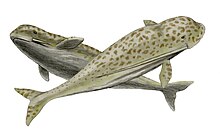

Is this an accurate depiction? The image was uploaded from a website not a reliable scholarly article. Wolverine XI (talk to me) 06:26, 19 March 2024 (UTC)
- Alerting @Armin Reindl, who wrote most of the current page. The Morrison Man (talk) 07:40, 19 March 2024 (UTC)
- For context, the issue was brought up at this FAC:[15] Could be nice if some supporting citations could be added to the Commons description. Added our other restoration here which could also need review. FunkMonk (talk) 11:48, 19 March 2024 (UTC)
- The NT image looks pretty close to the Mary Parrish illustration ([16] Fig. 18) but the flippers and tail fluke look oddly flimsy. The other image seems too walrus-like in morphology, they're missing melons in particular and the tusks are held at the wrong angle (should be parallel to the body in swimming). Lythronaxargestes (talk | contribs) 14:29, 19 March 2024 (UTC)
- I can agree that the fluke and flippers of the NT one could use a bit extra, tho I don't think the tusk is that big of a deal for the Pavel Riha illustration. Sure it would have been held differently habitually, but with the ridiculous range of motion these animals had I don't think its at all implausible that they moved their heads. Cetaceans strike all kinds of poses, so I don't think we should assume that the tusk position would be 100% locked in at all times. The head could use some extra soft tissue as well to resemble Parrish's illustration (and the figure 17 which features the orientation of the nostrils/blowhole), tho of course without going overboard (Muizon notes that tho present in leptodon the melon would still be rather reduced compared to other odontocetes).
- Also perhaps its because I'm a little out of it but could someone highlihgt whre in the Nasutoceratops discussion Odobenocetops (or NTs art) becomes relevant? Armin Reindl (talk) 17:17, 19 March 2024 (UTC)
- Oh, it's just me messing up by having several tabs open, here's the actual FAC link:[17] NT's restoration is probably most easily fixable, and is it it just me or does the skin of the Riha image look too wrinkly and not very cetacean-like? FunkMonk (talk) 17:58, 19 March 2024 (UTC)
- BTW, removed the image in case it's inaccurate. Wolverine XI (talk to me) 09:27, 20 March 2024 (UTC)
- Oh, it's just me messing up by having several tabs open, here's the actual FAC link:[17] NT's restoration is probably most easily fixable, and is it it just me or does the skin of the Riha image look too wrinkly and not very cetacean-like? FunkMonk (talk) 17:58, 19 March 2024 (UTC)
- I tried to make the fins of the NT image look less weird. FunkMonk (talk) 17:51, 24 March 2024 (UTC)
Castoroides dilophidus
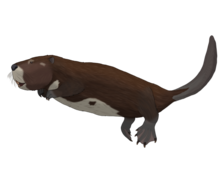
Made a recon of C. dilophidus in a swimming pose, we don't seem to have any images of this species on Wikimedia before this (the other Castoroides pics all seem to be C. ohioensis), leaving it here for review. Olmagon (talk) 00:27, 23 March 2024 (UTC)
- The article says "The tail was longer and may not have been paddle-shaped as in modern beavers". Here, it even looks shorter, and definitely paddle shaped. FunkMonk (talk) 14:39, 24 March 2024 (UTC)
I don't have the book the article cites so I'm not sure if it elaborates on that more, but this paper says "this would give the entire estimated length of the tail very nearly thirty inches", which doesn't sound very long on rodent the size of a black bear. I can't find papers on the tail shape but the figure in the paper linked shows caudal vertebrae that look more similar (though not identical) to a beaver's than a muskrat's or coypu's (which seems to be what most long-tailed reconstructions online base it on).I know this paper is talking about C. ohioensis but all the known differences between the two Castoroides species are in the skull so it shouldn't be a big issue to give C. dilophidus the same tail. Olmagon (talk) 20:05, 24 March 2024 (UTC)- Alright I changed the tail now, I had originally restored it wrong because I misinterpreted a sentence from Moore (1890). Where he said a 69-inch Castoroides would have a 30-inch tail, I wrongly thought the first measurement did not count the tail (since mammals are often measured like that). Had I read closer I'd have realized it was stated to be the length of the entire skeleton, and at the end of the paper he even straight up calls the tail "long". Also later papers like Barbour (1931) also call the tail long, this one in particular even having a skeletal. Olmagon (talk) 02:13, 25 March 2024 (UTC)
- Sure looks more natural! FunkMonk (talk) 09:16, 25 March 2024 (UTC)
A Bunch of Restorations by me
-
Acotherulum
-
Cebochoerus
-
Diplacanthus
-
Gervachoerus
-
Ichthyostega stensioei
-
Numidotherium koholense
-
Pamizinsaurus tlayuaensis
-
Ptolemaia grangeri
-
Sumidadectes chozaensis
-
Tetanopsyrus lindoei
-
Acanthodes lopatini
-
Ischnacanthus gracilis
-
Gyracanthides murrayi
SeismicShrimp (talk) 01:10, 26 March 2024 (UTC)
According to recent studies,[18][19] Bothriolepis had single dorsal fin and no pelvic fins. Last two images properly reconstructed that, but I wonder if it is possible to fix other reconstructions or just tag? Ta-tea-two-te-to (talk) 03:52, 28 March 2024 (UTC)
Qohelet12's Daidal
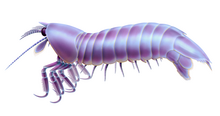
I know this picture by @Qohelet12 has been reviewed before but after a closer look I'm noticing some issues with it. The Daidal genus has 3 species and this picture is labelled as D. acanthocercus (the type species). However some features of this reconstruction seem to match D. schoellmanni more: the lateral extensions of the carapace stretching further back, the length of the spines on the raptorial appendages, and said appendages lacking a groove on the propodus (the segment with the spines). Yet it isn't a perfect match for schoellmanni either since its thoracic and abdominal segments are all around the same length (matching acanthocercus, but unlike schoellmanni whose thoracic segments are noticeably shorter than the abdominal segments). Furthermore, in all Daidal species the last abdominal segment has ridges and backward-pointing spikes (exact ornamentation differing between each species), whereas this illustration shows the segment to be smooth. For pictures of what each species should look like see figures 15 to 18 in Schram (2007). Olmagon (talk) 13:37, 28 March 2024 (UTC)
Pseudastacus lemovices
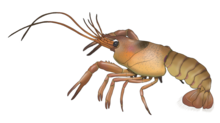
Made a life reconstruction of P. lemovices, leaving it here for review. Olmagon (talk) 01:03, 27 March 2024 (UTC)
- Looks good! The Morrison Man (talk) 09:09, 27 March 2024 (UTC)
- Maybe someone who often comments on invertebrates, like Fossiladder13, Ta-tea-two-te-to, and Junnn11, have something to add? FunkMonk (talk) 11:12, 27 March 2024 (UTC)
- As I see it looks fine, though I am not sure about decapod body plan. Ta-tea-two-te-to (talk) 14:33, 27 March 2024 (UTC)
- I agree with Ta-tea, it looks pretty good from comparing it to other fossils and the reconstructions I could find, however I will add that I could only find diagrammatic reconstructions, your’s seems to be one of, if not the first life restoration of this crustacean. Fossiladder13 (talk) 14:59, 27 March 2024 (UTC)
- There are seemly some anatomical issues:
- a: The surface was covered by tubercles (pereiopods and pleon should be smooth, carapace shoud be covered by pits, see page 98-99 of the original description).
- b: The lateral spines (on merus) and dactylus of the left 1st pereiopod located upside down (see fig. 2).
- c: The 1st segment of pleon was too big (should be small and laterally covered by 2nd segment pleura in living position).
- d: The protopod of the uropod seems to be too small, causing the exopod seperated from it and the endopod was directly connected to segment 6 (all should be articulated via protopod).
- (a) are diagnostic which seperated this species from P. pustulosus. Others are shared anatomy across Astacid decapods, thus I think the anatomy of any general-looking crayfish and lobster could be a good reference. Junnn11 (talk) 04:23, 30 March 2024 (UTC)
- Made the aforementioned fixes. I also posted my pustulosus further down if you have anything to comment on that. Olmagon (talk) 11:07, 30 March 2024 (UTC)
- Thanks for the update. It looks better!
- Here's another minor details on the basal section of pereiopods (just realized it recently, sorry for another notes!). Based on the size and angle, the basal segments in the artwork looks like ischium for pereiopod 1 and coxa for pereiopod 2-5, respectively. If that's the case, there should be more than 1 basal segment visible for each pereiopod in this posture and angle (see [20]). Specifically:
- pereiopod 1 lacking a coxa
- pereiopod 4 coxa seems to be a bit too long
- the merus-like section of pereiopod 2-5 lacking 1 basal joint (those seperating the short ischium and long merus, which is usually parallel to each other and looks like a single long merus from a distance. see "3" and "4" of this diagram).
- Junnn11 (talk) 14:47, 30 March 2024 (UTC)
- Proper segmenting now given to the limbs. Olmagon (talk) 17:46, 30 March 2024 (UTC)
- Made the aforementioned fixes. I also posted my pustulosus further down if you have anything to comment on that. Olmagon (talk) 11:07, 30 March 2024 (UTC)
- As I see it looks fine, though I am not sure about decapod body plan. Ta-tea-two-te-to (talk) 14:33, 27 March 2024 (UTC)
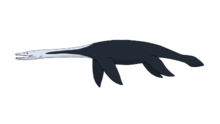
Made this artwork to be included in the Hauffiosaurus page. Are there any observations, before it can be uploaded? YellowPanda2001 (talk) 20:08, 13 March 2024 (UTC)
- Has crushing of the skull been accounted for? Also, the outline's a bit rough. Lythronaxargestes (talk | contribs) 20:50, 13 March 2024 (UTC)
- Agree that the outline also needs to be smoothed, plesiosaurs would have been streamlined animals. Also, while I understand that it's supposed to be simplified, the tooth arrangement, shape, and count does not line up with what we know about Hauffiosaurus zanoni at all, for example, the tooth row does not extend far back enough, there are only six teeth illustrated per side of the lower jaw here when there should be more than 30, and the teeth look somewhat too straight when they should be slender and recurved. I think the neck might also be a bit too long. --Slate Weasel [Talk - Contribs] 13:46, 15 March 2024 (UTC)

Hauffiosaurus zanoni updated - I updated the reconstruction to fit with the requested changes. I hope the skull and the teeth are better fitting, I tried looking up for better references for it. YellowPanda2001 (talk) 21:57, 20 March 2024 (UTC)
- Definitely looks better; I think that the region above the hips and anterior tail could probably be smoothed a bit more, but otherwise, it seems pretty accurate. Some shading would also be nice, if possible. --Slate Weasel [Talk - Contribs] 13:30, 24 March 2024 (UTC)

Hauffiosaurus zanoni updated 2 - Alright, I have updated it with the suggested corrections. Hopefully it looks better! YellowPanda2001 (talk) 23:45, 27 March 2024 (UTC)
- Looks fine to me --Slate Weasel [Talk - Contribs] 21:27, 30 March 2024 (UTC)
- Definitely looks better; I think that the region above the hips and anterior tail could probably be smoothed a bit more, but otherwise, it seems pretty accurate. Some shading would also be nice, if possible. --Slate Weasel [Talk - Contribs] 13:30, 24 March 2024 (UTC)
- Agree that the outline also needs to be smoothed, plesiosaurs would have been streamlined animals. Also, while I understand that it's supposed to be simplified, the tooth arrangement, shape, and count does not line up with what we know about Hauffiosaurus zanoni at all, for example, the tooth row does not extend far back enough, there are only six teeth illustrated per side of the lower jaw here when there should be more than 30, and the teeth look somewhat too straight when they should be slender and recurved. I think the neck might also be a bit too long. --Slate Weasel [Talk - Contribs] 13:46, 15 March 2024 (UTC)
Pseudastacus pustulosus
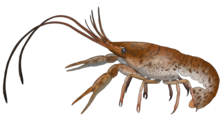
Made a reconstruction of a male Pseudastacus pustulosus now that I learned all those images of it on wiki are not recons but diagrams of extremely well-preserved fossils (Lagerstätte moment). Putting it here for review. Olmagon (talk) 01:26, 29 March 2024 (UTC)
- For this reconstruction:
- The antennula was missing the basal segments and seemly ventral to the antennal scale (you did it accurately in P. lemovices).
- The pleon missing the short 1st segment.
- Issues of pereiopod 1 dactylus and each basal region are the same as the aforementioned P. lemovices.
- It's worth to note that the available diagrams ommit some of the animal's detail (especially pereiopod bases, possibly due to the lack of preservation), and the ventral position of dactylus in some specimens are most likely taphonomic. In astacids, the dactylus of pereiopod 1 always located dorso-mesially in semi - completely outstretched posture (although it sometime did create a false impression of ventral position when view from certain angle). Junnn11 (talk) 14:49, 30 March 2024 (UTC)
- Made the changes listed. Olmagon (talk) 17:46, 30 March 2024 (UTC)
- Both reconstructions looks good now. Thanks again for the edits! Junnn11 (talk) 08:35, 31 March 2024 (UTC)
- Made the changes listed. Olmagon (talk) 17:46, 30 March 2024 (UTC)
Mosasaurus

This Mosasaurus is my first non-dinosaur. Please review for accuracy, but go easy on me! UnexpectedDinoLesson (talk) 00:25, 20 March 2024 (UTC)
- Pinging Macrophyseter. Also considering the great diversity in morphology between Mosasaurus species, a species should be specified. Lythronaxargestes (talk | contribs) 02:27, 20 March 2024 (UTC)
- Yes, and this is something that should be done for all genera with multiple species, as I've pointed out a bunch of times, otherwise images are bordering on useless when taxonomic revisions inevitably come. And in such cases, an image is most useful if it depicts a species in the genus we don't already have several restorations of, otherwise it may not be used at all. FunkMonk (talk) 07:30, 20 March 2024 (UTC)
- Updated to Mosasaurus hoffmannii. UnexpectedDinoLesson (talk) 13:34, 20 March 2024 (UTC)
- The artwork is that of a Tylosaurus based on the elongated rostrum and general shape of skull and forelimbs. Macrophyseter | talk 20:44, 20 March 2024 (UTC)
- Yes, and this is something that should be done for all genera with multiple species, as I've pointed out a bunch of times, otherwise images are bordering on useless when taxonomic revisions inevitably come. And in such cases, an image is most useful if it depicts a species in the genus we don't already have several restorations of, otherwise it may not be used at all. FunkMonk (talk) 07:30, 20 March 2024 (UTC)
- On the accuracy side, the teeth would probably not be this visible even with an open mouth, the closest modern analogy are monitor lizards, and even their long teeth aren't visible in side view with an open mouth. Not an expert, but I also think the individual scales are too large, probably wouldn't even be visible from this distance? FunkMonk (talk) 14:19, 20 March 2024 (UTC)
The teeth should go all the way to the end of the premaxilla. The elongated premaxilla with no teeth on the anterior end is a characteristic of Tylosaurus and its relatives. --A Cynical Idealist (talk) 21:46, 20 March 2024 (UTC)
- Mosasaurus does actually have a premaxillary rostrum, though much less extreme than in this restoration. The tail is too long proportionally for Mosasaurus, and overall this life restoration seems to match quite closely proportionally with Tylosaurus pembinensis ([21]). Regardless of whether this is Mosasaurus or Tylosaurus, there should be a caudal keel, the scales shouldn't be this large, and I have doubts about how plausible the wrinkles in the skin are, considering how streamlined hydropedal mosasaurs were. --Slate Weasel [Talk - Contribs] 13:39, 24 March 2024 (UTC)
- Proportions altered, scales made smaller, wrinkles reduced. I'm not familiar with the caudal keel, but I added a line of shading there to hopefully imply it in the right way. Let me know if anything else needs to be fixed. UnexpectedDinoLesson (talk) 21:41, 25 March 2024 (UTC)
- Looks better, though the preflexural (straight) part of the tail looks a bit too short now. Additionally, based on Prognathodon, the flippers could probably use more of a trailing edge. From what I've heard mosasaurids apparently wouldn't have had external ear openings. --Slate Weasel [Talk - Contribs] 21:24, 30 March 2024 (UTC)
- Preflexural lengthened, trailing edge added on flippers, ear hole removed. UnexpectedDinoLesson (talk) 23:14, 31 March 2024 (UTC)
- Looks better, though the preflexural (straight) part of the tail looks a bit too short now. Additionally, based on Prognathodon, the flippers could probably use more of a trailing edge. From what I've heard mosasaurids apparently wouldn't have had external ear openings. --Slate Weasel [Talk - Contribs] 21:24, 30 March 2024 (UTC)
- Proportions altered, scales made smaller, wrinkles reduced. I'm not familiar with the caudal keel, but I added a line of shading there to hopefully imply it in the right way. Let me know if anything else needs to be fixed. UnexpectedDinoLesson (talk) 21:41, 25 March 2024 (UTC)
Dermodactylus
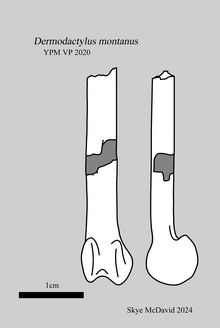
Putting this up for review before adding to the page. It's just an illustration of the actual fossil so not much to review, but let me know if there are any comments/objections. More info in my blog post if you're interested. Skye McDavid (talk) 00:20, 5 April 2024 (UTC)
-
Choerosaurus
Two Late Permian therapsids by Petr Menshikov. Any comments? Sittaco (talk) 14:05, 3 April 2024 (UTC)
- I recognise this is also a problem for the existing image on the page, but how sure are we about fur on Suminia? Also I'm not sure if this is perspective, but the pedal digits look subequal in length when this is pretty clearly not the case. Lythronaxargestes (talk | contribs) 18:17, 3 April 2024 (UTC)
- Can't be very sure about fur or no-fur on Suminia, but I'd argue the Choerosaurus are in the same boat—the only thing really going for fur on therocephalians is a slightly closer phylogenetic proximity to cynodonts. As is, a lot of our existing therapsid illustrations already include hair of varying degrees, so I think having another with hair is inoffensive (though it might be nice for future illustrations to balance it out a bit). From checking out the artist's timelapse of modelling it, the toes are definitely not subequal so I think that's just perspective, yeah. DrawingDinosaurs (talk | contribs) 17:10, 5 April 2024 (UTC)
Agnathans
-
Anglaspis heintzi
-
A. heintzi
-
Arandaspis prionotolepis
-
A. prionotolepis
-
Birkenia elegans
-
B. elegans
-
Cephalaspis lyelli
-
C. lyelli
-
C. lyelli
-
Drepanaspis gemuendenensis
-
D. gemuendenensis
-
Furcacauda fredholmae
-
F. fredholmae
-
Pteraspis rostrata
-
P. rostrata
-
Sacabambaspis janvieri
-
S. janvieri
A series of models of Paleozoic agnathans by Petr Menshikov. Any comments are welcome. Sittaco (talk) 13:34, 1 April 2024 (UTC)
- I wonder if Arandaspis actually had a caudal fin like this. Actual tail material is not known in Arandaspis, and this tail fin shape is estimated in original description in 1977,[22] and after that it was never get revision. But considering only other complete arandaspid Sacabambaspis actually had more complex shape of tail, it is more reasonable to give tail shape like that? Ta-tea-two-te-to (talk) 14:17, 1 April 2024 (UTC)
- @Ta-tea-two-te-to: Here is a WIP of the version with a Sacabambaspis-like tail. Sittaco (talk) 15:31, 6 April 2024 (UTC)
- Oh it looks better! And yeah as I see current pictures are upside down (see gills). Ta-tea-two-te-to (talk) 15:34, 6 April 2024 (UTC)
- @Ta-tea-two-te-to: Here is a WIP of the version with a Sacabambaspis-like tail. Sittaco (talk) 15:31, 6 April 2024 (UTC)
- Not a comment on accuracy but I'm not sure how to feel about all of these anterior views. They practically show none of the anatomy outside of the mouth. Lythronaxargestes (talk | contribs) 18:22, 3 April 2024 (UTC)
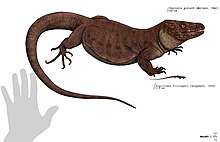
Noticed that this image was added by GallotiaFan without review. Sittaco (talk) 04:16, 7 April 2024 (UTC)
Marambionectes illustration
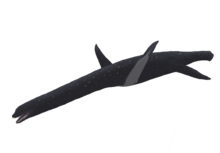
This illustration of the new weddellonectian plesiosaur was uploaded by ShamuBlackfish and added to the page without review by Amir Ali Iranshahi 3. I can re-add it to the page soon if it doesn't get any huge critiques. -SlvrHwk (talk) 18:06, 6 April 2024 (UTC)
- Looks like the lower jaw is dislocated. Like its pivot point isn't where it should actually attach. One front flipper also seems overly long, even taking perspective into consideration. FunkMonk (talk) 02:10, 7 April 2024 (UTC)
- Fair enough. I will say this is my first time submitting my work for an accuracy review so I don't know how quick or flexible I should be to correct my mistakes or to correct them in the first place. But if needed, I can simply shorten the front flipper since it is a simple change. ShamuBlackfish (talk) 06:02, 7 April 2024 (UTC)
- It's not urgent that you need to update the image; just fix what you can when you have time. You can directly upload a new version on top of the original by clicking "Upload a new version of this file" under "File history" on Commons. -SlvrHwk (talk) 06:26, 7 April 2024 (UTC)
- The file is now updated with the changes I’ve made for the Marambionectes so it should be present. Feel free to point out any other inaccuracies. ShamuBlackfish (talk) 03:54, 8 April 2024 (UTC)
- It's not urgent that you need to update the image; just fix what you can when you have time. You can directly upload a new version on top of the original by clicking "Upload a new version of this file" under "File history" on Commons. -SlvrHwk (talk) 06:26, 7 April 2024 (UTC)
- I made the corrections for the flipper and the lower jaw and SlvrHwk responded with a link to upload a new version of the file so I will do so. If there any other changes I should make, I’ll fix them since I seem to have enough time to do so. ShamuBlackfish (talk) 07:02, 7 April 2024 (UTC)
- http://commons.wikimedia.org/wiki/File:Marambionectes_molinai_png.png
- Here’s a new version with the corrections I made. If there’s anything else I need to fix, I’ll be open to do so. ShamuBlackfish (talk) 07:23, 7 April 2024 (UTC)
- Fair enough. I will say this is my first time submitting my work for an accuracy review so I don't know how quick or flexible I should be to correct my mistakes or to correct them in the first place. But if needed, I can simply shorten the front flipper since it is a simple change. ShamuBlackfish (talk) 06:02, 7 April 2024 (UTC)
Theriiformes of Late Cretaceous North America
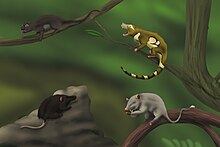
Made this artwork to represent the diversity of mammals that would have existed in the Late Cretaceous of North America. I don't know in which context they would be best introduced in a page, but thought of placing it here for review in any case. YellowPanda2001 (talk) 22:42, 11 April 2024 (UTC)
Any need for a Smilosuchus?
here i hav an illustration of Smilosuchus Gregorii [23]
is it good and could i add it alongside another illustration of the head of Smilosuchus Adamenensis?? LiterallyMiguel (talk) 22:30, 16 April 2024 (UTC)
New placoderm reconstructions
-
???
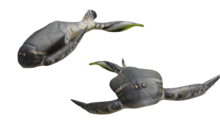
Work by @PlacodermReconstructions:. Some are replaced without review. Those models look fine to me but any opinions? Also PlacodermReconstructions, are you interested in making new reconstruction of Bothriolepis canadensis based on this study[24] since most others reconstructed fins outdated? (your previous drawing looks not good at proportion to be honest) Ta-tea-two-te-to (talk) 09:13, 24 April 2024 (UTC)
- Seeing as the ones added to articles simply replace old versions by the same user, I see no issue with that. The Morrison Man (talk) 10:17, 24 April 2024 (UTC)
- That is true. I see. Ta-tea-two-te-to (talk) 10:37, 24 April 2024 (UTC)
- I am interested in reconstructing this antiarch. PlacodermReconstructions (talk) 01:12, 25 April 2024 (UTC)
- It looks nice to me! Probably better to remove space around that, and background is too dark to see? Ta-tea-two-te-to (talk) 01:37, 25 April 2024 (UTC)
- Removed some space and background, as in the other placoderm images I've done. PlacodermReconstructions (talk) 02:41, 25 April 2024 (UTC)
- It looks nice to me! Probably better to remove space around that, and background is too dark to see? Ta-tea-two-te-to (talk) 01:37, 25 April 2024 (UTC)
Xiphodon and Mixtotherium
Hey all, some new reconstructions of weirdo artiodactyls of Eocene Europe
-
Size Comparison for Mixtotherium
-
Mixtotherium Portrait
-
Size comparison for Xiphodon
-
Xiphodon
Triloboii (talk) 03:43, 24 April 2024 (UTC)
- Looks good to me. I think some might express concern about the speculative neck being featured in the Mixtotherium head reconstruction, but I don't think that'll prove a major problem. PrimalMustelid (talk) 05:28, 25 April 2024 (UTC)
Miscellaneous by Hemiauchenia
-
Skull of Morganucodon
-
Skull of Gephyrosaurus
-
Skull of Polysphenodon
-
Skull of Brachyrhinodon
-
Skull of Cynosphenodon
Somewhat belated for a number of these, my apologies. Hemiauchenia (talk) 22:43, 20 April 2024 (UTC)
- The Morganucodon looks like it has a toothless snout tip (unlike in this pic for example), but it's pretty nice otherwise. —Trilletrollet [ Talk | Contribs ] 14:00, 24 April 2024 (UTC)
- It's like that in the figure that I primarily used for reference [25]. This version also shows the presence of a gap (though less prononuced). There seems to be inconistencies between how various authors reconstuct the front end of the snout in Morganucodon (For example the 1981 monograph left the nasal open, as seen in this restoration (figure b)) which I am unsure how to harmonise. Hemiauchenia (talk) 23:39, 25 April 2024 (UTC)
- Decided to add the lower jaw because why the hell not. Hemiauchenia (talk) 01:23, 26 April 2024 (UTC)
- Nice, it looks much better now. —Trilletrollet [ Talk | Contribs ] 16:42, 26 April 2024 (UTC)
- Decided to add the lower jaw because why the hell not. Hemiauchenia (talk) 01:23, 26 April 2024 (UTC)
- It's like that in the figure that I primarily used for reference [25]. This version also shows the presence of a gap (though less prononuced). There seems to be inconistencies between how various authors reconstuct the front end of the snout in Morganucodon (For example the 1981 monograph left the nasal open, as seen in this restoration (figure b)) which I am unsure how to harmonise. Hemiauchenia (talk) 23:39, 25 April 2024 (UTC)
- Is it possible to add some additional dashed lines to Cynosphenodon indicating roughly what the rest of the skull would look like? Lythronaxargestes (talk | contribs) 15:43, 26 April 2024 (UTC)
- I based the interpolated outlines on the ones in the original 1996 description. This was when the anatomy of basal members of Sphenodontinae was poorly known, and so therefore the interpolated complete skull in the 1996 paper was pretty generic. However, in 2022, a much more complete basal member of Sphenodontinae Navajosphenodon was described, which would presumably be a closer match to what the skull of Cynosphenodon actually looked like, and this is quite different to the generic restoration in the 1996 paper. and it would suggest the the borders interpolated for the known skull bones in the 1996 paper are probably incorrect. I'm kind of unsure how to proceed in harmonising a new skull outline in a coherent way. Hemiauchenia (talk) 20:59, 26 April 2024 (UTC)
-
Reconstruction in use
-
Size comparison
-
Size comparison in use
I just uploaded cropped version of Nobu Tamura's new Utatsusaurus since it looks more accurate than previous one, but are there problems? Also created new size chart based on Motani et al. (1998)[26] since older one looks oversized and body shape is inaccurate. Ta-tea-two-te-to (talk) 16:27, 14 April 2024 (UTC)
- How come the kink in the tail is much more pronounced in the new size chart? Lythronaxargestes (talk | contribs) 19:55, 14 April 2024 (UTC)
- I just traced over original figure, although yeah, it would be better to have some speculative tail fin? Although I am not sure about its shape. Ta-tea-two-te-to (talk) 01:58, 15 April 2024 (UTC)
- image updated with more straight tail with tail fin. Ta-tea-two-te-to (talk) 02:28, 15 April 2024 (UTC)
- I must confess that I'm not super comfortable with how closely the presacral part of the new silhouette matches the Motani e.a. skeletal for copyright reasons. I don't think neck flexibility in Utatsusaurus has ever been studied but the two NT illustrations seem to be showing a rather generous interpretation for an animal with such a short neck and a streamlined body (moreso in the older one). --Slate Weasel [Talk - Contribs] 13:35, 24 April 2024 (UTC)
- That is true. However, it is quite difficult to draw the proportions accurately while still not resembling the original drawing. If it's a problem, I'll remove it and let someone else create a better chart. Ta-tea-two-te-to (talk) 04:04, 26 April 2024 (UTC)
- Now remade with more original limbs and tail. Ta-tea-two-te-to (talk) 01:50, 27 April 2024 (UTC)
- Looks good! --Slate Weasel [Talk - Contribs] 14:09, 27 April 2024 (UTC)
- Now remade with more original limbs and tail. Ta-tea-two-te-to (talk) 01:50, 27 April 2024 (UTC)
- That is true. However, it is quite difficult to draw the proportions accurately while still not resembling the original drawing. If it's a problem, I'll remove it and let someone else create a better chart. Ta-tea-two-te-to (talk) 04:04, 26 April 2024 (UTC)
- I must confess that I'm not super comfortable with how closely the presacral part of the new silhouette matches the Motani e.a. skeletal for copyright reasons. I don't think neck flexibility in Utatsusaurus has ever been studied but the two NT illustrations seem to be showing a rather generous interpretation for an animal with such a short neck and a streamlined body (moreso in the older one). --Slate Weasel [Talk - Contribs] 13:35, 24 April 2024 (UTC)
- image updated with more straight tail with tail fin. Ta-tea-two-te-to (talk) 02:28, 15 April 2024 (UTC)
- I just traced over original figure, although yeah, it would be better to have some speculative tail fin? Although I am not sure about its shape. Ta-tea-two-te-to (talk) 01:58, 15 April 2024 (UTC)

Here's a life restoration of Aegirosaurus, one of the most completely known ichthyosaurs but badly in need of images on WP. How does it look? --Slate Weasel [Talk - Contribs] 21:44, 30 March 2024 (UTC)
- Note I just added two photos of the specimen preserving blubber[27], taken when it was apparently not identified to genus, hence the "unnamed" filenames. FunkMonk (talk) 21:50, 30 March 2024 (UTC)
- Looks good but a little blurry. Are those two nostrils? Lythronaxargestes (talk | contribs) 18:26, 3 April 2024 (UTC)
- I see what you mean about blurriness; I'll try to fix that over the weekend if my schedule permits it. Also, yeah, those are two orifices in the narial region; while Aegirosaurus does not have the bifid external naris of some ophthalmosaurids, it is bilobed, and the full division evolved several times independently in ophthalmosaurs (derived platypterygiines, Baptanodon, Arthropterygius thalassonotus), presumably supporting multiple orifices. Since Aegirosaurus would fall into the bracket for a separate salt gland(?) opening, I chose to illustrate it as having such, I can remove this though if too speculative. --Slate Weasel [Talk - Contribs] 13:12, 24 April 2024 (UTC)
- Made an attempt to sharpen it; does this look better? --Slate Weasel [Talk - Contribs] 15:05, 27 April 2024 (UTC)

Noticed this was added by Mario Lanzas without review. Are there any issues for that? Ta-tea-two-te-to (talk) 00:11, 31 March 2024 (UTC)
- Would the end of the tail have been that flexible? It's not a nasorostran. Lythronaxargestes (talk | contribs) 00:24, 1 April 2024 (UTC)
- Compared to C. petrinus I'm also concerned that the tail is significantly too long relative to the presacral length; the tail fin might also be too long relative to the preflexural segment though considering that the tail of C. petrinus is incomplete there should be some more leeway there. --Slate Weasel [Talk - Contribs] 15:10, 27 April 2024 (UTC)
pteranodon (geosternbergia) maysei
Pteranodon sternbergi review for accuracy
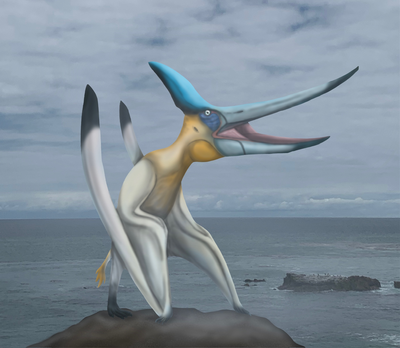
Jfstudiospaleoart (talk) 14:52, 30 April 2024 (UTC)
- This looks very strange. Maybe it's the demarcation of the gular pouch that makes the entire neck look very shrinkwrapped, maybe it's the excessively large torso. Lythronaxargestes (talk | contribs) 15:48, 30 April 2024 (UTC)
- What is the source for the background image? Is it your own photo? -SlvrHwk (talk) 16:47, 30 April 2024 (UTC)
- yes its a photo I took in california Jfstudiospaleoart (talk) 16:55, 30 April 2024 (UTC)
Paleoart request : Fossil hyraxes and a review of Dmitry Bogdanov's Titanohyrax
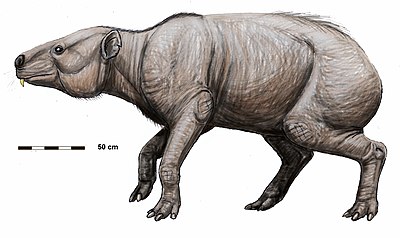
I've recently started working on the Parapliohyrax article, which should be finished tonight. Constating that hyraxes reconstructions are not only rare, but the papers containing their descriptions are, in most cases, and like those of a large number of other Cenozoic taxa, wildly unavailable to public access, it could be good if at least scale charts could be realized about the Pliohyracidae and the Titanohyracidae.
If a potential artist is interested to give a more deep look into this group to create a life reconstruction, and search for taxa known from good materials and important locations, I can recommend Saghatherium (known from extensive postcrania), Antilohyrax, Afrohyrax, Thyrohyrax, Megalohyrax, Prohyrax, Pachyhyrax, Parapliohyrax and Postschizotherium. Skeletal diagrams are welcome too, specially for postcrania.
As an aside, the recent reconstructions of Pliohyrax and Kvabebihyrax by @ДиБгд: (Dmitry Bogdanov) are both well-executed and quite educative. The reconstruction of Titanohyrax, here presented, however, posted 12 years ago, has aged quite a lot ; it is quite skinwrapped, with an almost complete loss of fur (a condition that is rare in most mammals of its size) and I'm not sure about some of the feet articulations (given the lack of postcranial material, these long limbs being seemingly based, with a good reasoning, on its smaller parent Antilohyrax, despite the important size difference.) Given that extinct hyracoids are not the group with the most reconstructions out there, I'd recommend keeping it on page for the time being, until a more up-to-date reconstruction is provided - the edits needed being probably too important to simply modify it. Larrayal (talk) 18:37, 30 April 2024 (UTC)
- I assume the lack of fur on the Titanohyrax has more to do with the article saying it may have been semi-aquatic rather than because of its size? FunkMonk (talk) 18:46, 30 April 2024 (UTC)
- I'd be happy to take a look at some of these when I get a chance, such cool animals! Triloboii (talk) 20:31, 30 April 2024 (UTC)
Already reported in Discord server, but A.C. Tatarinov (yes, again) uploaded AI-generated reconstruction of Postschizotherium and used that in Russian Wikipedia article. This is surely problematic... Ta-tea-two-te-to (talk) 01:25, 5 May 2024 (UTC)
New DBogdanov mammals (and other things)
DBogdanov just uploaded so many new drawings that I thought it best to make a new section rather than add them to the previous one where they may be overlooked. I don't know anything about any of these, but on the Discord server it was mentioned that the Hyaenodonhas a way too large head and is based on a chimaeric specimen (head could be shrunk if we want to use it). I also think I read somewhere that hyaenodonts are supposed to have been plantigrade, but these restorations are all digitigrade. Is it incorrect? FunkMonk (talk) 19:22, 25 January 2024 (UTC)
- The Hyaenodon looks like a mammalian Erythrosuchus lol. —Trilletrollet [ Talk | Contribs ] 19:35, 25 January 2024 (UTC)
- Someone on Discord made that exact point hehe. Apparently based on this:[28] FunkMonk (talk) 19:39, 25 January 2024 (UTC)
- Yeah, that specimen is definitely chimaeric, and yes, hyaenodonts had a plantigrade stance. I already talked about this in the discord, but the Gorgonops is probably inaccurate based on the presence of whiskers, because most papers I could find, like Benoit (2019) suggest whiskers first appeared in the Probainognathia. Fossiladder13 (talk) 22:23, 25 January 2024 (UTC)
- PrimalMustelid pointed out that at least derived hyaenodonts were digitigrade? And I've added three new uploads. FunkMonk (talk) 12:07, 27 January 2024 (UTC)
- @FunkMonk Oh, I was going off the Hyaenadonta article, but good to know that some were digitigrade at least. Someone else
- pointed this out in the discord, but the fin spines and gills of the Orthacanthus should have more flesh covering them. Fossiladder13 (talk) 18:49, 27 January 2024 (UTC)
- How would that look, Fossiladder13? Any image references if I try to fix it? Added some more images too. FunkMonk (talk) 16:37, 17 February 2024 (UTC)
- @FunkMonk, I totally forgot about this, thank you for reminding me. On the topic of the fin spines, they should probably look like these
- •https://www.deviantart.com/hodarinundu/art/Diving-with-Orthacanthus-798344700
- •https://www.deviantart.com/esthervanhulsen/art/Orthacanthus-and-Xenacanthus-772704178
- the spines and gills would have been visible, but would have been covered by flesh. Fossiladder13 (talk) 16:45, 17 February 2024 (UTC)
- So the spine should just be the same colour as the skin? And the horizontal lines on the gills should just be removed to make it look like they're covered? FunkMonk (talk) 16:48, 17 February 2024 (UTC)
- That would be the best course of action I think, though It is probable that the tip of the fin spine would have been exposed, with the majority being hidden. Fossiladder13 (talk) 16:51, 17 February 2024 (UTC)
- Fossiladder13 so I'm not entirely sure how the spines differ from the examples you posted, so it should only be the very tip that's exposed? FunkMonk (talk) 21:55, 21 February 2024 (UTC)
- @FunkMonk Sorry to not be as specific about it, the spines currently are fine (the tip being exposed at least) I believe the problem is that the spine itself should not be jutting out that much (the base should be buried more). Fossiladder13 (talk) 22:05, 21 February 2024 (UTC)
- So I get it right before I do anything, Fossiladder13, I drew some lines[29] of where there could be more flesh, is that what you meant? FunkMonk (talk) 20:08, 23 February 2024 (UTC)
- @FunkMonk pretty much, the neck needed more flesh, that’s looks better. Fossiladder13 (talk) 20:11, 23 February 2024 (UTC)
- How does this[30] look for the spines and gills, Fossiladder13? FunkMonk (talk) 20:49, 23 February 2024 (UTC)
- @FunkMonk comparing it to other art work, the body looks much more uniform with the extra flesh added. The gills also look much better. Fossiladder13 (talk) 20:54, 23 February 2024 (UTC)
- Cool, I've updated the image and might add it to the article. FunkMonk (talk) 20:58, 23 February 2024 (UTC)
- @FunkMonk comparing it to other art work, the body looks much more uniform with the extra flesh added. The gills also look much better. Fossiladder13 (talk) 20:54, 23 February 2024 (UTC)
- How does this[30] look for the spines and gills, Fossiladder13? FunkMonk (talk) 20:49, 23 February 2024 (UTC)
- @FunkMonk pretty much, the neck needed more flesh, that’s looks better. Fossiladder13 (talk) 20:11, 23 February 2024 (UTC)
- So I get it right before I do anything, Fossiladder13, I drew some lines[29] of where there could be more flesh, is that what you meant? FunkMonk (talk) 20:08, 23 February 2024 (UTC)
- @FunkMonk Sorry to not be as specific about it, the spines currently are fine (the tip being exposed at least) I believe the problem is that the spine itself should not be jutting out that much (the base should be buried more). Fossiladder13 (talk) 22:05, 21 February 2024 (UTC)
- Fossiladder13 so I'm not entirely sure how the spines differ from the examples you posted, so it should only be the very tip that's exposed? FunkMonk (talk) 21:55, 21 February 2024 (UTC)
- That would be the best course of action I think, though It is probable that the tip of the fin spine would have been exposed, with the majority being hidden. Fossiladder13 (talk) 16:51, 17 February 2024 (UTC)
- So the spine should just be the same colour as the skin? And the horizontal lines on the gills should just be removed to make it look like they're covered? FunkMonk (talk) 16:48, 17 February 2024 (UTC)
- How would that look, Fossiladder13? Any image references if I try to fix it? Added some more images too. FunkMonk (talk) 16:37, 17 February 2024 (UTC)
- PrimalMustelid pointed out that at least derived hyaenodonts were digitigrade? And I've added three new uploads. FunkMonk (talk) 12:07, 27 January 2024 (UTC)
- Yeah, that specimen is definitely chimaeric, and yes, hyaenodonts had a plantigrade stance. I already talked about this in the discord, but the Gorgonops is probably inaccurate based on the presence of whiskers, because most papers I could find, like Benoit (2019) suggest whiskers first appeared in the Probainognathia. Fossiladder13 (talk) 22:23, 25 January 2024 (UTC)
- Someone on Discord made that exact point hehe. Apparently based on this:[28] FunkMonk (talk) 19:39, 25 January 2024 (UTC)
- Even more hyaenodonts now added, among others. I've just tagged the Hyaenodon macrocephalus with the big head as inaccurate for now, not worth fixing when there are so many other restorations to choose from anyway. FunkMonk (talk) 21:55, 21 February 2024 (UTC)
- Added a bunch of new phorusrhacids. Is it just me or do some of their head proportions seem off, especially in Andalgalornis steulleti, Psilopterus lemoinei, and Hermosiornis milneedwardsi? And shouldn't Paraphysornis brasiliensis have a sickle claw as the rest? FunkMonk (talk) 19:48, 25 February 2024 (UTC)
- Next time Bogdanov adds stuff, we need to create another thread, this one is kinda pointless and obviously unreviewed anymore. Larrayal (talk) 23:43, 29 March 2024 (UTC)
- Added some others. Ta-tea-two-te-to (talk) 15:25, 7 May 2024 (UTC)
Found this, how is it good, I haven't seen original description and proper interpretation other than Peters. Ta-tea-two-te-to (talk) 06:01, 10 April 2024 (UTC)
- Artistically it's quite nice; though I am concerned that the snout might be too short (I have not yet done a detail proportions check though). Additionally, the nostrils seem to be located at the very tip of the snout; a configuration unknown in any ichthyosauromorph. --Slate Weasel [Talk - Contribs] 13:16, 24 April 2024 (UTC)
- When I increased the brightness and looked closely, I realized that it had hind legs with toes. This seems to be a common for most artwork in Thaisaurus, but since David Peters is one reconstructed it, I'm not sure if it's reliable. Ta-tea-two-te-to (talk) 23:57, 5 May 2024 (UTC)
- We already discussed this on the Discord server, but for the record here, yes, there is definitely no good reason to assume independent toes in Thaisaurus, whose hindlimbs are incomplete from the metatarsals down, and is in the bracket for flippered hindlimbs formed by other ichthyopterygians, hupehsuchians, and omphalosaurids. --Slate Weasel [Talk - Contribs] 16:32, 7 May 2024 (UTC)
- When I increased the brightness and looked closely, I realized that it had hind legs with toes. This seems to be a common for most artwork in Thaisaurus, but since David Peters is one reconstructed it, I'm not sure if it's reliable. Ta-tea-two-te-to (talk) 23:57, 5 May 2024 (UTC)















